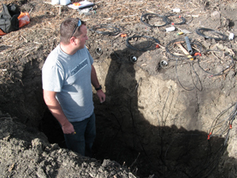To really understand subtle changes in our planet — like moisture held in the topmost earth layer — and their impacts on agriculture and the environment, scientists have to know what is going on in our soils.
In 2010, Agriculture and Agri-Food Canada (AAFC) began setting up a network of soil monitoring stations to provide soil moisture, soil temperature and meteorological data and capture conditions for the main agricultural crop types, soil textures and “eco-zones” in Canada. This network is known as Real-time In-situ Soil Monitoring for Agriculture (RISMA).
The monitoring stations continually measure and report the latest data in near real-time. In many cases, the data can be accessed online within an hour of the sampling. A web-based application developed by FieldVision, out of Waterloo, Ontario, allows for easy viewing, synthesis and manipulation of the data.
This information can then be used by local producers for day-to-day operational decisions or by scientists for verification and calibration of soil moisture values obtained from satellite imagery. AAFC's overall research and development efforts are already helping the agricultural sector by constantly improving our capacity in crop yield modeling, drought monitoring and flood forecasting.
By 2015, the RISMA Network expanded to a total of 22 soil-monitoring stations representative of soils and landscapes across Canada. The sites are located at Kenaston, Saskatchewan (four stations), Carman–Elm Creek, Manitoba (nine stations), Sturgeon Creek, Manitoba (three stations) and Casselman, Ontario (five stations). An additional station is found at AAFC's Central Experimental Farm in Ottawa.

Kurt Gottfried, an AAFC Resource Analyst, installing soil moisture probes in an excavated pit on the farmer's field at Station 5 south of Elm Creek, Manitoba.
"Our stations are installed in annually cropped fields and provide us with vital soil information as well as meteorological data,” says Anna Pacheco, environmental analyst for remote sensing for AAFC in Ottawa. “Those measurements in near real-time help us test new sensor technology, support our satellite-based soil research and model development, and allow us to collaborate with other science organizations. Monitoring soil moisture will enable the sector to better mitigate agricultural risks on a regional and national basis."
AAFC is now providing the U.S. National Aeronautics and Space Administration (NASA) with data from RISMA’s soil monitoring stations at Carman–Elm Creek and Casselman.
Data sharing will occur for the duration of the Soil Moisture Active Passive (SMAP) mission, which runs until 2018. AAFC’s ground-based information will be used to assess data coming from NASA’s satellite and test soil moisture mapping products.
AAFC’s RISMA Network is supported by Environment Canada, the University of Guelph, University of Manitoba, and the Global Institute for Water Security at the University of Saskatchewan. AAFC also acknowledges the landowners for permission to install and access our stations and data surveys on their properties.






Post a comment
Report Abusive Comment